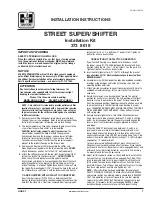
2.
Inspect the exterior surfaces of brake chambers
for damage. Make sure that breather holes are
open and free of debris.
NOTE: Do not route air brake lines on top of
anything likely to be stepped on.
3.
Inspect air brake lines for dents, swelling, kinks,
twisting, abrasion, and damage, especially near
moving parts.
4.
Inspect flex air lines for deterioration or signs of
abrasion.
5.
Inspect for cracked, worn, or oil-contaminated
brake linings and brake drums (or rotors).
6.
Check the thickness of the brake linings. Re-
place brake linings on all brake assemblies on
the axle if any brake linings are worn to less than
approximately 1/4 inch (6.4 mm) at the thinnest
point.
Saddle Tank Area Inspection
WARNING
When draining the air reservoir, do not look into
the air jets or direct them toward anyone. Dirt or
sludge particles may be in the airstream and
could cause injury.
NOTICE
If the water drained from the air reservoirs is
cloudy or oily, it may indicate a problem with the
compressor. If oil is allowed to contaminate the
air dryer, it will not remove the water from the air
brake system, which could adversely affect brak-
ing.
1.
Drain the brake system air reservoirs (reservoirs
with automatic drain valves only).
2.
Inspect the batteries.
WARNING
Battery posts, terminals, and related accessories
contain lead and lead compounds, chemicals
known to the State of California to cause cancer
and reproductive harm. To prevent possible per-
sonal injury, always wash your hands after han-
dling battery parts and related accessories.
2.1
Remove the battery box cover and inspect
all visible battery cables for loose wiring or
damage.
2.2
Check that the battery hold-down is se-
cure.
Engine Compartment Inspection
Tilt the cab. See
for instructions.
1.
Check the hydraulic clutch reservoir, if equipped.
If necessary, add DOT 4 brake fluid.
2.
Inspect the radiator and heater hoses, including
the clamps and support brackets.
2.1
Inspect the radiator and charge air cooler
for damage and accumulated debris.
Straighten bent or damaged fins to permit
airflow across all areas of the cores.
NOTE: When traveling through areas of high
insect concentration, it may be necessary to
clean the exterior of the radiator or the
charge air cooler core as often as every 200
miles (322 km).
2.2
Make sure the radiator inlet and outlet
hoses are pliable and are not cracking or
ballooning.
2.3
Make sure the heater hoses are pliable
and are not cracking or ballooning.
2.4
Tighten hose clamps as necessary.
IMPORTANT: Do not overtighten hose
clamps, as hose life can be adversely af-
fected.
2.5
Ensure hose support brackets are se-
curely fastened. Make sure hoses are not
located near sources of wear, abrasion, or
high heat.
IMPORTANT: When replacing hoses, install
service-type knitted or braided yarn-reinforced
neoprene hose. Extended-service-life silicone
hoses may also be used. See the Alliance Parts
Catalog at
or
contact your Freightliner dealer.
Pre- and Post-Trip Inspections and Maintenance
23.10
Summary of Contents for Run Smart ARGOSY
Page 1: ...ARGOSY STI 385 2 A24 00879 000 Driver s Manual...
Page 4: ...1 Vehicle Identification Component Information Label 1 1...
Page 58: ...6 Climate Control Cab Climate Control Panel 6 1 Sleeper Climate Control Panel 6 2...
Page 73: ...8 Cab and Sleeper Features Windows 8 1 Mirrors 8 1 Cab Amenities 8 1 Sleeper Amenities 8 2...
Page 84: ...11 Emissions Reduction Components Exhaust Aftertreatment System Optional 11 1...
Page 88: ...09 25 2006 f610816a Fig 11 5 HEST Lamp Emissions Reduction Components 11 4...
Page 97: ...13 Steering System Steering System General Information 13 1...
Page 120: ...16 Drive Axle Feature Operation Differential Lock 16 1 Interaxle Lock 16 2...





































